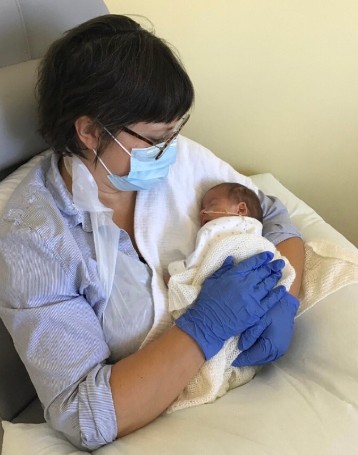Elizabeth and Penny’s Story

I was fortunate to have had access to information and doctors who were vigilant. Penny was fortunate to have been cared for in an exceptional NICU. But not everyone has access to that level of support…
Pregnancy did not agree with me. I felt awful all of the time and it took all my energy to make it through the working day. Nausea made everything challenging. Sciatica meant I could not find a comfortable position. Eczema prevented me from having warm showers and baths. There were moments of joy – seeing Rizzo (our pet name for P) wiggling around during the ultrasound scans. Finding out we were having a girl and then walking home along the seafront accompanied by a glorious sunset – the glowing joy we were feeling inside projected for everyone to see. She would increasingly make her presence known through her nightly kicking sessions. A little mystery who was slowly becoming more real.
Then Covid happened and Sam could no longer attend midwife and obstetrics appointments with me, which was difficult but understandable. At the start of the year, I had decided to take my maternity leave as early as possible, so I could try to enjoy some of my pregnancy without the commute – have massages, spend time researching all the baby gear, meeting with friends for coffee. This romanticised version of my third trimester began to wane. I was disappointed but thankful that, so far, my pregnancy had been healthy.
Then my blood pressure became a bit high – well why wouldn’t it?! There was a global pandemic on the rise. To be on the safe side I started having weekly BP readings at the midwifery unit and I bought myself a home reader. Then my BP was a bit higher and I started having headaches and experiencing visual disturbances. There was protein in my urine – I wanted to write it off as nothing, but I couldn’t ignore the fact that they were all signs of pre-eclampsia. I went in for my weekly reading and sat in an empty waiting room for ages. The reception had been closed because of reduced services and I had to flag down a midwife after waiting for over half an hour. No wonder my BP was high when she took the reading, right? But better be safe than sorry. She called the Maternity Assessment Unit (MAU) and they said they could see me in an hour. Sam was waiting outside for me, and when I emerged in a flood of tears, he called our friend Ant to see if he could drive us to the hospital. Ant came to our rescue and would do so again many times.
At the hospital, they hooked me up to a monitor to check P’s movements and they ran a bunch of blood tests. After 4 hours, a doctor came in and told me that based on kidney and liver function combined with high blood pressure and protein in my urine, I had pre-eclampsia. It was common so not something to worry about. She gave me a prescription for labetalol and said we would just need to keep an eye on it. She didn’t really provide much detail or seem concerned. In fact, she gave me very little to go by. I had heard about pre-eclampsia but it hadn’t really been on my fear radar. We walked home from the hospital, it was a dark and cold journey. That was the first day of my maternity leave.
Following that initial visit to the MAU, I began reading more about the condition and the dangers of it turning into eclampsia, which was much more serious and dangerous to mother and baby. On April 1st I took my regular morning reading and it was very high. I called the MAU who said to come in right away. So, I got into a cab alone, as Sam was no longer allowed to attend appointments with me at the hospital, not knowing what lay ahead of me. They ran the same batch of tests, and thankfully this time I had an excellent doctor who explained the situation to me calmly and in detail. He recommended that I be admitted for observation because while things weren’t extremely worrying, they were worrying. I was overwhelmed – what did this mean? I was so unprepared. My brain was so fuzzy, and I kept a notebook in order to write down what the doctors said so that I could tell Sam when we spoke. The doctors joked with me about it but keeping records and trying to understand what was going on was the only way I could have some control over the situation.
I stayed in the antenatal ward for two days and was cared for by some very lovely midwives. Teams of consultants and junior doctors would do their rounds – asking me the same questions about headaches, etc., and testing my reflexes. These became a vital indicator of the severity of my condition as they were very quick. At first, they talked about trying to keep the baby in until 37 weeks, but that changed to at least 31 weeks. On the afternoon of April 2nd, I began a magnesium treatment that would last for 24 hours as a measure to protect Penny and help prevent the possibility of me having a stroke. I have never experienced anything so awful. I was sick for the next 15 hours. The first anti-nausea medication made me high as a kite but didn’t stop the vomiting. The second one didn’t do anything. Finally, the third one allowed me to hold down some toast. During that time, I was in and out of sleep but could not rest as they were checking my BP every hour and running blood tests every few hours.
I was scheduled for a caesarean on April 4th. P’s movements were less frequent and there was a good possibility that she might have to be delivered earlier. On the morning of the 4th, a glorious bright and sunny day, Sam cycled to the hospital and joined me. I hadn’t seen him since I’d been admitted on the 1st, but it felt like it had been so much longer. During that time, I hadn’t showered and only managed to brush my teeth once. My face was red and swollen (another sign of pre-eclampsia), my lips chapped and bleeding. It was such a physical experience and yet I felt completely detached from what my body was going through. The surgical team came in and gave us a run-through of the procedure, which would also include new COVID precautions. The anaesthetist was incredible. She explained everything so clearly and reassured me that she would be there by my side throughout.
At 12.31 the surgeons plucked P into the world and announced her arrival with “congratulations”. The midwife, who was waiting in the wings, came and whisked her away – briefly stopping so we could see her. This little red and blue creature staring at us – an alien, an old man, our girl! While they finished stitching me up, P was placed in a plastic bag and intubated before being taken up to the NICU. Sam was able to stay with me for a while and during that time, he went up to the NICU and met P. New regulations were in place there, too, and no phones were allowed. Fortunately, a nurse let Sam take some photos of P to show me. Covered in wires and tubes, she was not the baby I had imagined, and I felt guilty that I didn’t recognise her. We looked at the photos together, exhausted, relieved and confused. At midnight the doctors did their rounds and Sam was told he couldn’t stay any longer. He cycled home in the darkness. I was left alone in my dark room, a birthing room that didn’t have any lamps. Baby Penner was upstairs in her incubator, her first lullaby the beeping of machines.

The following day, I managed to move from my bed into a wheelchair so that I could go and visit P. I was wheeled into the NICU where I had to don a mask, gloves, and an apron. P was the first baby in the room, and I began crying immediately upon seeing her. I was able to put my hand into the incubator and stroke her, though I was sweating in the gloves and couldn’t help but wonder how I would bond with her with so many barriers between us.
I was in hospital for a further 6 days. Initially, I was able to go and visit P whenever and for however long I wanted – the only restriction being that Sam wouldn’t be able to visit on the same day. Then the rules changed – only one parent per day and only for a two hour period. Eventually, further restrictions would mean we could only visit for two hours in the morning. Each time I went, I cried because I just couldn’t get my head around the situation. I felt like a visitor, not a mum – even when I held her for the first time, I was scared because of all the wires and beeping machines. I couldn’t smell her or kiss her – I couldn’t even take photos of her. The nurses were brilliant and set up a service where they would take photos and send them to us. We would come to live for those images of her.
Finally, I was discharged and being at home with Sam was the best medicine. Within a week my BP had dropped significantly and over the next few weeks I was able to gradually reduce my medication. But all of that seemed secondary to P and her progress. Sam and I would take turns going out to the hospital, keeping to a rigorous routine to avoid people and not bring germs into the hospital or house. She made great progress and always in her own time. We knew how fortunate we were that the length of her stay was due to her needing to finish “cooking” rather than because of any serious medical conditions.
I was fortunate to have had access to information and doctors who were vigilant. Penny was fortunate to have been cared for in an exceptional NICU. But not everyone has access to that level of support. Wouldn’t it be more equitable and sustainable to have a better understanding of this condition? The POPPY study is such an important step in raising awareness, gaining critical knowledge and possibly treating preeclampsia.
